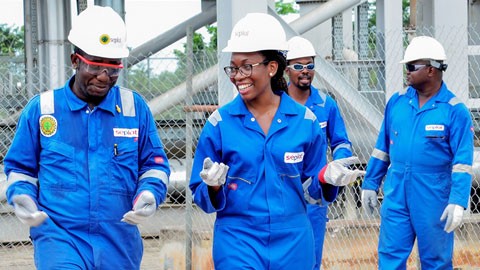Business
Seplat transforms from marginal player to national oil giant

The unpredictability of the nation’s lucrative, but highly volatile oil and gas industry can quickly burst the bubble of a new entrant not strategic and resilient enough to ride the odds and adversities.
But Seplat Energy Plc, an indigenous oil and gas company, has been able to weather the storm to become not only a profitable entity churning out huge dividends year-on-year to its shareholders, but an industry giant in a sector where many of its peers have fallen by the way.
Defying all economic headwinds, the company recently announced an unprecedented H1′ 2025 performance, reporting a revenue surge to N2.167 trillion, a staggering 277 percent increase from N575.1 billion recorded in the same period of 2024.
According to Business Hallmark’s analysis of the report, Seplat’s Earnings Before Interest, Tax, Depreciation and Amortisation (EBITDA) for the period under review rose sharply to N1.139 trillion from N364.5 billion in the same period last year.
Likewise, operating profit climbed to N601.2 billion from N285.2 billion, while cash generated from operations hit N1.188 trillion, up from N308.2 billion – a 286 percent increase year-on-year.
Growth in Output
Further breakdown of the report shows that Seplat’s average crude oil production during the period rose by 178 percent to 134,492 barrels per day (bpd), significantly above the midpoint of its full-year guidance range of 120,000 to 140,000 bpd. According to the company, this included a working interest oil output of 100,327 barrels per day.
Specifically, while offshore assets contributed 79,660 bpd of the output, onshore fields delivered 54,831 bpd — up 13 percent year-on-year.
The offshore segment saw an 11 percent quarter-on-quarter increase in Q2’25 production, supported by improved uptime and the restoration of 29 previously idle wells, which added nearly 26,000 barrels per day in gross capacity.
The company also highlighted a strong operational safety record, achieving 15.3 million man-hours without a Lost Time Injury (LTI), underscoring its emphasis on safety and operational excellence.
Also, Seplat continued to make strides in its decarbonization strategy, with a 15 percent reduction in carbon emissions intensity on its onshore assets to 26.7 kg CO₂/boe. The firm said it remains on track to eliminate routine flaring from its onshore operations by the end of 2025.
In financial terms, revenue for the half-year in dollar terms was $1.398 billion (N2.146 trillion), a 231 percent increase from $422 million in H1 2024.
Meanwhile, adjusted EBITDA rose to $735 million, up from $267.3 million, while cash flow from operations reached $766.2 million, reflecting stronger earnings and prudent cost controls.
Seplat’s unit production operating cost was contained at $12.5 per barrel despite inflationary pressures. The production cost is below its guidance of $14–15/barrel, thanks in part to the timing of planned maintenance activities.
The company also demonstrated its financial resilience, reducing its net debt to $676 million, down 9.5 percent from the previous quarter, with a pro-forma net debt-to-EBITDA ratio improving to 0.53x.
Post-period, Seplat repaid $100 million on its revolving credit facility (RCF), leaving the $350 million facility fully available and un-drawn at the end of July.
The oil company’s cash at bank stood at $419.4 million, excluding $133 million in restricted cash. These balance sheet improvements have not gone unnoticed, with Fitch and Moody’s both upgrading Seplat’s credit ratings in recent months.
Capital expenditure during the period under review was measured at $96.5 million, slightly lower than the $102.4 million recorded in the first half of 2024, keeping the company well on course to meet its full-year capex guidance of $260 million to $320 million. These include $180–220 million targeted for onshore developments and $80–100 million allocated for offshore operations.
Gas Production Prospect
Seplat also announced that its ANOH gas plant received its first dry gas volumes in July 2025, a critical step towards full commissioning of the facility.
The gas infrastructure project, considered one of the most strategic in Nigeria’s energy mix, is expected to bolster domestic gas supply and support the company’s future earnings profile.
Seplat also maintained its strong track record of shareholder returns in H1’2025. According to the report, the company declared a dividend of 4.6 cents per share. This translates to a dividend payout of N33.37 when converted using the exchange rate of N1,535 to a dollar.
The company, meanwhile, reaffirmed its commitment to a revised capital allocation strategy, which it said would be unveiled at its Capital Markets Day on September 18, 2025.
Speaking on the impressive result, Seplat Energy Plc’s Chief Executive Officer, Roger Brown, expressed confidence in the company’s trajectory.
“Seplat has continued its positive momentum in the second quarter, delivering strong production, especially from our offshore assets, which grew by 11 percent quarter on quarter.
“Our first-half production was over 10 percent higher than the pro forma output of the same period last year, meeting both our internal goals and contributing to Nigeria’s national production targets”, Brown said.
He added that the company’s strong cash flows, prudent cost discipline, and reduced leverage provide a solid foundation for long-term growth.
“We are well positioned to withstand macroeconomic volatility. In addition to reducing our net debt and maintaining a steady dividend, we’ve laid a strong foundation to achieve our 2025 performance targets”, he noted.
Today, few brands are as nationally recognizable as Seplat. According to BH findings, Seplat’s journey from a small marginal player to one of the biggest players in Nigeria’s oil and gas sector is a remarkable story of vision, resilience, and strategic genius.
Steady Investment Growth
Established in June 2009 as Seplat Petroleum Development Company by experienced industry entrepreneurs, including Austin Avuru and Greg McNair, the company set out to pursue opportunities in Nigeria upstream oil and gas industry.
In July 2010, Seplat completed its first major acquisition by acquiring 45 percent stake in three onshore producing oil and gas blocks in the Niger Delta (OMLs 4, 38 and 41), producing 30,000 bpd.
In June 2013, Seplat acquired interest in the Umuseti/Igbuku marginal field area within OPL 283, and in February 2015 acquired interests in OML 53 and OML 55.
By the end of 2015, it has grown its oil production to a peak rate of 85,200 barrels per day.
Alongside its crude oil business, the company has also developed its gas reserves. Between 2015 and 2016, Seplat installed and commissioned a new 375 million cu ft/d (10.6 million m3/d) gas processing facility at its Oben hub, taking gross overall processing capacity to 525 million cubic ft/d (14.9 million m3/d).
In February 2015, Seplat made a major move by purchasing stakes in two onshore Nigeria blocks from Chevron Nigeria for a combined $391.6 million. In 2021, Seplat changed its name from Seplat Petroleum Development Company to Seplat Energy in 2021.
Perhaps, the firm’s biggest corporate coup is the purchase of Mobil Producing Nigeria Unlimited in December 2022 from ExxonMobil for $1.28 billion.
However, the deal was stalled for two years, when the Nigerian National Petroleum Company (NNPC) challenged it in court, claiming it had the first right of refusal over the assets.
The controversy was, however, resolved after the new administration of President Bola Ahmed Tinubu intervened in the matter.
According to available data, the acquisition added significant assets to Seplat’s portfolio, including: 40% operated interest in OML 67, 68, 70, and 104, 40% operated interest in the Qua Iboe export terminal, and the Yoho FSO, 51% operated interest in the Bonny River Terminal (BRT) NGL recovery plant, and 9.6% participating interest in the Aneman-Kpono field.
As part of the deal, Seplat also inherited ExxonMobil’s highly experienced 1,000 staff and 500 contractors.
Bolstered By Divestment
Seplat’s acquisition of oil assets divested by exiting International Oil Companies (IOCs) has meanwhile propelled the company to a new production high.
From a humble output of below 10,000 barrels per day in 2010, Seplat has pushed its daily production to 140,000 barrels, making it the biggest ingenious oil producer in the country.
Not only that, Seplat has become the fastest growing Nigerian company in the last three years, beating high performance companies like Dangote Cement, MTN Nigeria, Nestle, Nigerian Breweries Plc (NB Plc), and Transcorp Group.
For instance, while the Dangote Group, before now Nigeria’s best-performing company by revenue, reported a 17.7% year-on-year increase in pre-tax profit of $1.35 billion (N2.072 trillion) for the first half of 2025, Seplat’s half-year revenue grew by 277% to N2.167 trillion, N95 billion more than Dangote’s.
Industry experts attributed Seplat’s Q1’2025 stellar performance to record-breaking production, disciplined cost management, and a robust safety record, which they claimed have cemented its leadership position in the nation’s upstream oil and gas sector.
According to a financial expert, Dr. Peju Beckley, Seplat’s impressive performance is a good testament to the ongoing recovery of Nigeria’s Petroleum industry.
“What makes this news more palatable is that it is an indigenous company like Seplat, First Hydrocarbon, Heirs Energy, and Oando that are performing these feats. I know it will surprise many people that it is indigenous companies that are at the heart of the revival of our oil and gas industry.
“According to available data, local producers are now responsible for about 60% of the current oil production in the country. I applaud President Tinubu for opening up the industry for growth. And I think that is the best way to go, not only for the oil and gas industry, but other sectors of the economy.
“Like Dangote Refinery and Seplat have shown, Nigerians can do wonders if given the incentives”, Dr. Beckley admonished.





